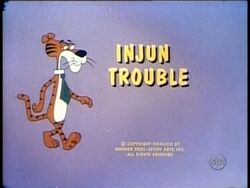Deprecated
We have moved to portable infoboxes using the new Template:Shorts
Please do not use this template anymore. It is left here for reference purposes.
| Injun Trouble | |||||||||||||||||||||||||||||||||||||||||||||
| |||||||||||||||||||||||||||||||||||||||||||||
|



Injun Trouble is a 1969 animated cartoon short in the Merrie Melodies series, directed by Robert McKimson and featuring Cool Cat (voiced by Larry Storch). It is noted for being the final cartoon in the original Looney Tunes and Merrie Melodies series, ending a run which had lasted since 1930.
The next Merrie Melodies cartoon would be 1988's "Night of the Living Duck". The cartoon shares its name with an earlier short directed by Bob Clampett, which was filmed in black-and-white.
Title
The title is a play on the phrase "engine trouble," substituting "Injun" which is slang for "Indian" or Native American.
Plot
Cool Cat is driving to the town of Hotfoot one day, when his route happens to take him through a Indian reservation. Two scouts spot him and one of them gives chase, only to fall into a chasm when the weight of him and his horse causes the makeshift bridge to collapse (even though it had carried Cool Cat and his car without trouble). Cool Cat rescues them and continues his journey. Along the way, he encounters a man who tries to give his heavily obese daughter away, a more attractive woman that invites him for an "Indian Wrestle" (which turns out to be a fight with a man who is far larger than Cool Cat), a literal bareback rider and a Native American who uses a stenograph-like device to create smoke signals which read "COOL CAT GO HOME!"
Finally arriving in Hotfoot, Cool Cat spots two horses playing human shoes. After that, Cool Cat spots a "Topless Saloon" and heads in, but finds out that the only topless person in there is the bartender, a rather burly man. An outlaw named Gower Gulch then arrives and seemingly challenges Cool Cat to a duel, but then settles for a game of poker. Cool Cat gets a good hand with four Aces, only for Gulch to get a Royal Flush. Announcing that he is "cutting out," Cool Cat produces a pair of scissors and cuts a hole out of the background, which he then disappears into. He then reappears for a moment and ends the cartoon (and series) with the words "So cool it now, ya hear?"
Controversy
Owing to controversy over its stereotyping of Native Americans, with even the title bearing an offensive slur, and some racy jokes such as the "topless saloon", the cartoon has never been shown by United States television broadcasters, or released on video. While bootleg versions are available (most commonly with a time code on the print), it is one of the rarest of all Warner Bros. cartoons[1], owing to the relative unpopularity of cartoons from this era of the studio (unlike the "Censored Eleven," which were produced during the studio's heyday).
Gallery
TV Title Cards
References
- ^ The Most Obscure Warner Bros. Cartoons of All Time, accessed January 7, 2008



































